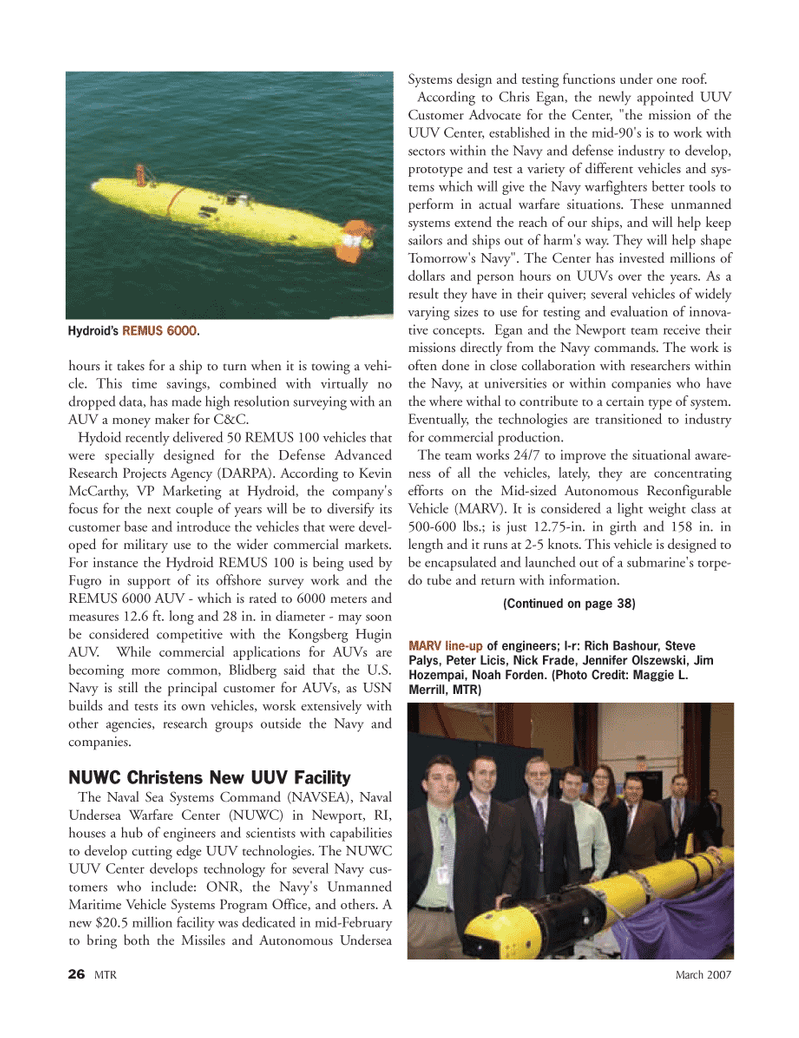
Page 26: of Marine Technology Magazine (March 2007)
AUVs, ROVs, UUVs
Read this page in Pdf, Flash or Html5 edition of March 2007 Marine Technology Magazine
26 MTR March 2007 hours it takes for a ship to turn when it is towing a vehi- cle. This time savings, combined with virtually no dropped data, has made high resolution surveying with an
AUV a money maker for C&C.
Hydoid recently delivered 50 REMUS 100 vehicles that were specially designed for the Defense Advanced
Research Projects Agency (DARPA). According to Kevin
McCarthy, VP Marketing at Hydroid, the company's focus for the next couple of years will be to diversify its customer base and introduce the vehicles that were devel- oped for military use to the wider commercial markets.
For instance the Hydroid REMUS 100 is being used by
Fugro in support of its offshore survey work and the
REMUS 6000 AUV - which is rated to 6000 meters and measures 12.6 ft. long and 28 in. in diameter - may soon be considered competitive with the Kongsberg Hugin
AUV. While commercial applications for AUVs are becoming more common, Blidberg said that the U.S.
Navy is still the principal customer for AUVs, as USN builds and tests its own vehicles, worsk extensively with other agencies, research groups outside the Navy and companies.
NUWC Christens New UUV Facility
The Naval Sea Systems Command (NAVSEA), Naval
Undersea Warfare Center (NUWC) in Newport, RI, houses a hub of engineers and scientists with capabilities to develop cutting edge UUV technologies. The NUWC
UUV Center develops technology for several Navy cus- tomers who include: ONR, the Navy's Unmanned
Maritime Vehicle Systems Program Office, and others. A new $20.5 million facility was dedicated in mid-February to bring both the Missiles and Autonomous Undersea
Systems design and testing functions under one roof.
According to Chris Egan, the newly appointed UUV
Customer Advocate for the Center, "the mission of the
UUV Center, established in the mid-90's is to work with sectors within the Navy and defense industry to develop, prototype and test a variety of different vehicles and sys- tems which will give the Navy warfighters better tools to perform in actual warfare situations. These unmanned systems extend the reach of our ships, and will help keep sailors and ships out of harm's way. They will help shape
Tomorrow's Navy". The Center has invested millions of dollars and person hours on UUVs over the years. As a result they have in their quiver; several vehicles of widely varying sizes to use for testing and evaluation of innova- tive concepts. Egan and the Newport team receive their missions directly from the Navy commands. The work is often done in close collaboration with researchers within the Navy, at universities or within companies who have the where withal to contribute to a certain type of system.
Eventually, the technologies are transitioned to industry for commercial production.
The team works 24/7 to improve the situational aware- ness of all the vehicles, lately, they are concentrating efforts on the Mid-sized Autonomous Reconfigurable
Vehicle (MARV). It is considered a light weight class at 500-600 lbs.; is just 12.75-in. in girth and 158 in. in length and it runs at 2-5 knots. This vehicle is designed to be encapsulated and launched out of a submarine's torpe- do tube and return with information.
Hydroid’s REMUS 6000.
MARV line-up of engineers; l-r: Rich Bashour, Steve
Palys, Peter Licis, Nick Frade, Jennifer Olszewski, Jim
Hozempai, Noah Forden. (Photo Credit: Maggie L.
Merrill, MTR) (Continued on page 38)
MTR#2 (17-32).qxd 3/2/2007 11:07 AM Page 26

 25
25

 27
27
